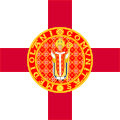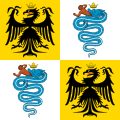Lombard nationalism

Lombard nationalism is a nationalist, but primarily regionalist, movement active primarily in Lombardy, Italy. It seeks more autonomy or even independence from Italy for Lombardy and, possibly, all the lands that are linguistically or historically Lombard.[1] During the 1990s, it was strictly connected with Padanian nationalism.
Today the main Lombard nationalist parties are the Lombard League and Pro Lombardy Independence.
History
Like in the rest of Europe, during the
The first independence movements appeared in the first half of the 19th century. Carlo Porta, one of the most important Lombard intellectuals, presented his adhesion to this idea in some writings.[4][5] They were often associated with Italian federalist movements, but they considered Lombardy as a nation instead a mere administrative division of the future state:
Che vegga Italia e la nazion lombarda
strette ad un pattoThat I'll see Italy and the Lombard nation
close to a deal— Pater Noster (dei Milanesi), a patriotic song of 1848[6]
During the Five Days of Milan in 1848, at first, insurgents only wanted greater autonomy for Lombardy in the Austrian Empire, with the possibility to administrate itself. A large part of the leaders of the insurrection, such as Carlo Cattaneo, was opposed to the Piedmont intervention.[7][8]
After the annexation to the Kingdom of Sardinia (and the creation of the Italian state), it seemed that some republican and federalist movements wanted the creation of a State of Milan, because of the cultural, economical and social differences between Lombardy and the rest of Italy.[9][10]
During the
In the 1950s, some small movements for autonomy appeared
From the legacy of this experiences[21] in the 1980s, the Lombard League was founded (since 1989 part of the Northern League). During the years, its political goal shifted between the separatism and the ask for a greater autonomy in the Italian state.[22] In 2018, the independentist tendency was officially abandoned by the federal secretary Matteo Salvini,[22][23] after five years of ambiguity.[24]

In the first decades of the 21st century, some cultural initiative and political parties appeared (among which
In 2017, an

After the latest elections for the
Definition of Lombardy

During the ages, the concept of Lombardy changed quite frequently. In

Linguistically, the
Some independence parties use alternative expressions, such as
Symbolism
The Lombard movements today don't have a unique symbol recognized by all.
The statue of Legnano Warrior, erroneously identified as Alberto da Giussano, was first used in the end of 1950s by the journal La Regione Lombarda, official organ of the Movimento Autonomista Regionale Lombardo.[36][37] Later it was adopted by the Lombard League and finally became the symbol of the Northern League; today is recognized only as a symbol of that political party.[38]
The
-
St. Ambrose Cross (as used by the City of Milan)
-
Flag of the Golden Ambrosian Republic
-
The Ducale (flag of the Duchy of Milan and modern symbol of Insubrian ethnicity)
-
Camunian rose (flag of the Lombard Region)
-
Flag of 1848 federalists
References
- ^ a b c "La Lombardia storica" (in Italian).
- ^ "Carlo Botta – Biografia". Treccani (in Italian).
- ^ "Polo Costituzionale per la Repubblica Lombarda" (PDF) (in Italian).
- ^ "5 Gennaio. Carlo Porta, grande poeta italiano di lingua milanese" (in Italian).
- ^ "Monumento a Carlo Porta" (in Italian).
- ^ "PATER NOSTER (DEI MILANESI)" (in Italian).
- ^ "Savoia o federalismo? La svolta centralista nelle Cinque giornate della Milano insorta" (in Italian).
- ^ "Carlo Cattaneo". Treccani (in Italian).
- ^ a b Napoleone Colajanni. L'Italia nel 1898: Tumulti e reazione (in Italian).
- ^ Romano Bracalini. "Fu Milano a tentare la prima secessione dall'Italia. E lo fece la sinistra!".
- ^ "General strike now in Italy" (PDF). Sherbrooke Daily Record. 11 August 1913.
- ^ "MORE MILAN RIOTS; 30,000 TROOPS OUT; Strike Leaders Demand the Separation of Lombardy from Rest of Italy" (PDF). The New York Times. 10 August 1913.
- ^ S2CID 149319048.
- ^ Guido Calderoli (1958). Zibaldone autonomista d'un montanaro bergamasco (in Italian). Bergamo: Tip. TOM. IT\ICCU\SBL\0490367.
- ^ Anselmo Freddi (1963). Breve storia del MAB (in Italian). Bergamo: Tip. F.lli Carrara.
- ^ a b c "Movimento autonomista bergamasco" (in Italian).
- ISBN 978-8849843002.
- ^ "Lega Nord, il futuro ha un cuore antico che sta nelle valli e ha riscoperto il segno della croce" (in Italian).
- ^ "Che cosa vuole il M.A.R.L." (in Italian). Archived from the original on 1 May 2018. Retrieved 1 May 2018.
- ^ "Risultati elezioni 1958" (in Italian).
- ISBN 978-8807172076.
- ^ a b "Lega Nord (dizionario di storia)". Treccani (in Italian).
- ^ "Salvini: "Nel 2018 la Lega non parla più di secessione"" (in Italian).
- ^ "Lega Nord, la base chiede ancora la secessione a Salvini: "Ok il consenso, ma non dimenticare il tuo popolo"" (in Italian).
- ^ "Dal Pirellone alla Laguna: indipendentismo lombardo-veneto" (in Italian). Archived from the original on 30 April 2018. Retrieved 29 April 2018.
- TheGuardian.com.
- ^ "Il Veneto supera il quorum (57,2%), Sì al 98,1%. Lombardia, affluenza del 38,5%" (in Italian).
- ^ "Regione Lombardia, ecco i 6 punti della trattativa con Roma sull'autonomia" (in Italian).
- ^ "Autonomia, Regione Lombardia: "Ripartiranno le trattative col nuovo governo"" (in Italian).
- ^ a b c "La Lombardia medievale (sec. VI – XII) – Istituzioni storiche" (in Italian).
- ^ a b c Gilberto Oneto. "Come si chiama questa Terra?" (PDF). Quaderni Padani N.2 – 1995 (in Italian): 7–8.
- ^ e.g. Vincenzo Maria Coronelli (1706). Lombardia ch ́ abbracia Gli Stati De ́ Duchi Di Savoja, Mantova, Parma E Modona, E Del Milanese (in Italian).
- ^ a b "Lombardi, dialetti". Treccani (in Italian).
- ^ "Lombardia Etnica" (in Italian).
- ^ "Europe of Nations".
- ^ "Il simbolo del Carroccio? Nacque prima della Lega (lombarda)" (in Italian).
- ^ "I segreti dello spadone da Giussano" (in Italian).
- ^ "La storia del simbolo della Lega Nord" (in Italian).
- ^ "Croce di San Giorgio: la bandiera dei lombardi" (in Italian).
- ^ "Il ducale simbolo dell'Insubria non è inventato" (in Italian).
- ^ "Collettivo Avanti: Rosa Camuna la nostra bandiera" (in Italian).
- ^ "Proposta per una bandiera lombarda" (in Italian).
- ^ "A flag for Northern Italy".
- ^ "The many Crosses of St. George". 20 April 2015.
- ^ "Bene la bandiera lombarda, ma niente italianate" (in Italian). Archived from the original on 28 March 2022.





